Getting people to show up to your event boils down to one thing: creating undeniable value and communicating it effectively. It's less about a single, massive promotional push and more about building a steady drumbeat of excitement that starts months out. You need a multi-channel approach that creates sustained buzz and turns that early interest into real, tangible social proof.
Building Your Pre-Event Promotional Engine
The road to a sold-out event starts long before the doors open. To succeed, you need a cohesive campaign that weaves together social media, smart content marketing, and strategic partnerships to build unstoppable momentum.
First, you have to know exactly who you're talking to. Who is your ideal attendee? What are their biggest professional headaches, and where do they hang out online? Once you have those answers, you can meet them where they are with a message that clicks. Your value proposition needs to be crystal clear. Why should they spend their time and money with you? Make the answer compelling and obvious.
Crafting a Content-Driven Campaign
Think of your content calendar as the backbone of your promotional strategy. Your goal is to fill it with a diverse mix of assets that build anticipation day by day.
- Speaker Spotlights: Don't just post a headshot and a bio. Share short Q&A videos or blog posts where your speakers drop a few knowledge bombs, giving a taste of what’s to come.
- Behind-the-Scenes Glimpses: People love seeing how things are made. Post photos or quick videos of venue walkthroughs, planning sessions, or tech checks. It makes the event feel real and humanizes your brand.
- Sneak Peeks of Experiences: If you have something unique planned, show it off. An AI-powered photo booth, for example, can produce wild and creative images. Teasing these possibilities taps into FOMO (fear of missing out) and puts a spotlight on the fun, interactive side of your event.
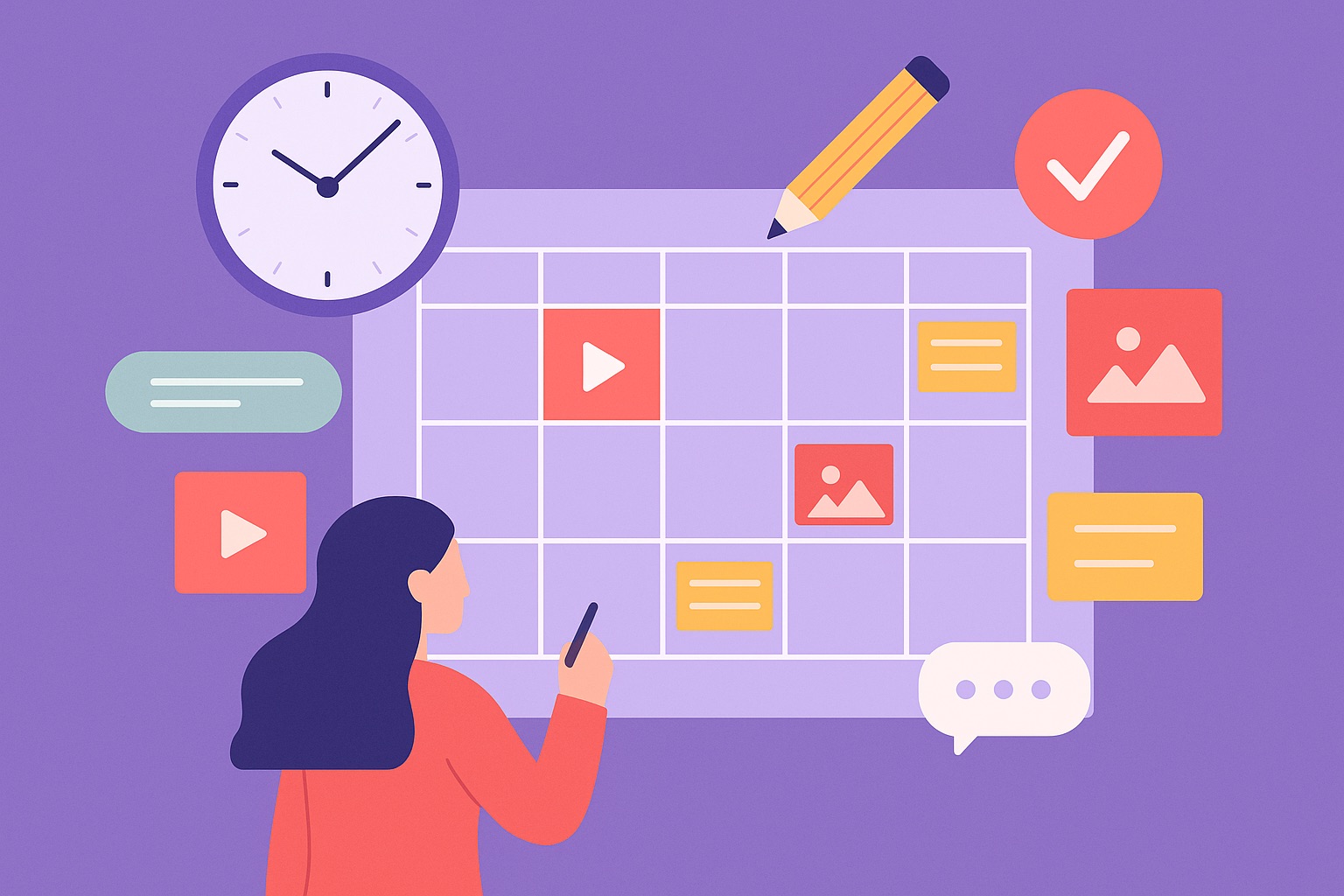
When you create content that's genuinely valuable and easy to share, you turn your audience into your most powerful marketing channel.
Using Urgency and Partnerships to Drive Action
Early-bird pricing is not just a discount; it's a strategic tool. It injects a healthy dose of urgency and rewards the people who are ready to commit. Those first sign-ups provide powerful social proof. When potential attendees see that others are already on board, it validates the event's value and nudges them to register.
The smartest promotional strategies tap into the networks of others. Your speakers, sponsors, and key partners all have an interest in a packed house. Make it incredibly easy for them to spread the word by providing a "promotional toolkit." This should include pre-written social media posts, on-brand graphics, email copy, and a unique tracking link so they can see their impact. This simple step amplifies your reach by tapping into communities that already know and trust them.
A physical touchpoint can also make a huge impression in a digital-first world. Consider exploring custom promotional giveaways to create buzz that goes beyond the screen. By blending these digital and physical tactics, you create a comprehensive strategy that makes your event impossible to ignore.
Using Technology to Craft a Better Attendee Journey
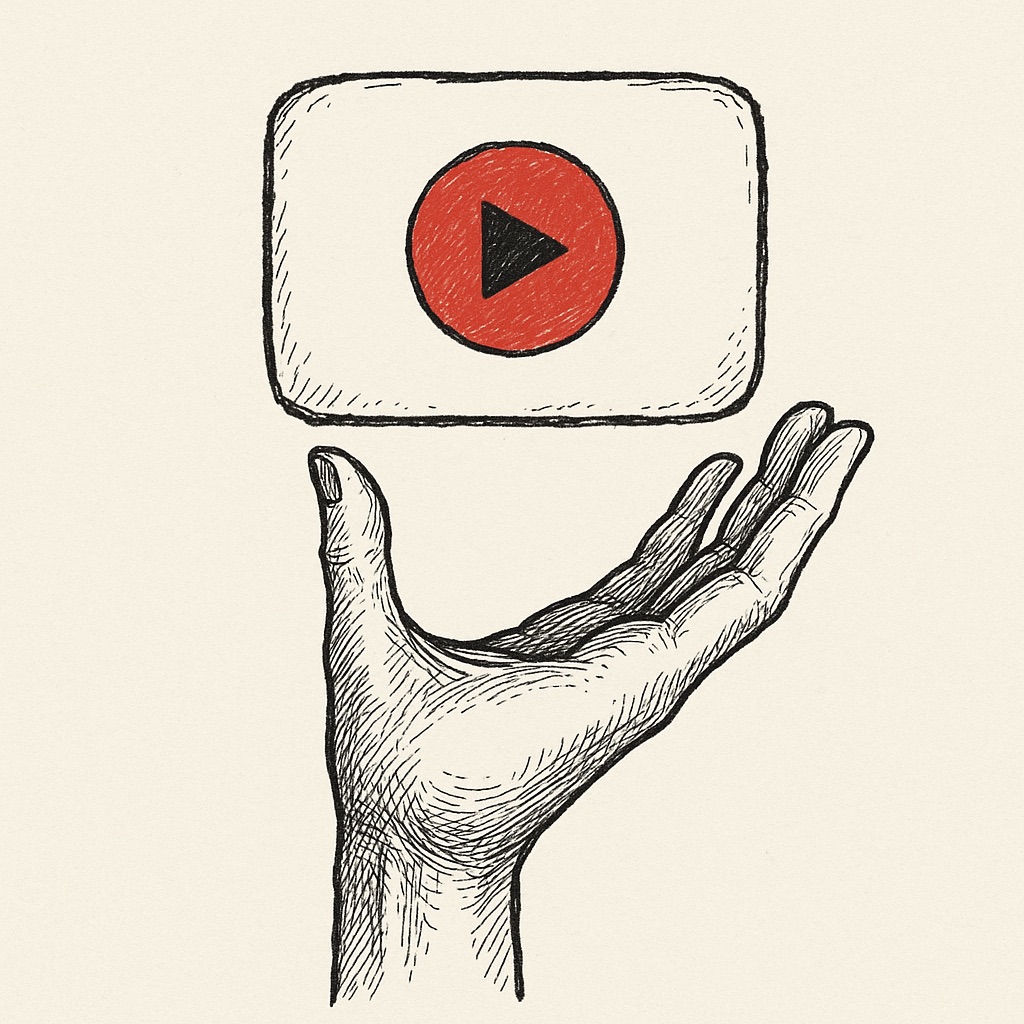
Technology is no longer just a behind-the-scenes tool for events. It is now a core part of the experience, and it can be the very thing that convinces someone to click "register." A smooth, intuitive journey for your attendees, powered by the right tech, is one of your most persuasive tools for boosting attendance.
This journey kicks off the second a potential guest hits your registration page. If that process is clunky, confusing, or too long, you are creating friction that leads to drop-offs. Your first impression needs to be seamless, showing attendees that your event is professional, modern, and respectful of their time.
Streamlining the First Touchpoint
Your registration platform is the digital front door to your event. It needs to be welcoming, not a barrier. When evaluating your own process, prioritize simplicity and user experience above all else.
- Mobile-First Design: A huge chunk of your audience will likely register on their phones. Ensure your forms are responsive and simple to fill out on a small screen.
- Fewer Fields: Only ask for what you absolutely need. Every extra box to fill out is another reason for someone to abandon the process.
- Clear Path to Checkout: The journey from "register" to "payment confirmed" should be obvious and take as few clicks as possible.
Getting this initial interaction right does not just reduce frustration; it directly helps increase event attendance by making it easy for interested people to follow through.
Promoting Unique Tech as a Core Attraction
Beyond slick registration, technology itself can be a massive selling point. To get people genuinely excited to sign up, promise them an experience they cannot get anywhere else.
Instead of just marketing your speakers and sessions, start marketing the experiences. An AI photo booth that creates professional headshots or drops attendees into wild, branded scenes is a huge draw. A gamified survey that unlocks personalized content or prizes makes participation fun and interactive.
By marketing the experience alongside the content, you completely change the value proposition. The event is no longer just about learning; it is about participating, creating, and sharing memorable moments. This strategy gives attendees something tangible to look forward to and something they'll want to share.
The event industry is leaning heavily into this. Data shows the percentage of organizers planning to host more events is set to jump from 41% to 66% between 2023 and 2025. This growth is supported by tech, with 79% of professionals now using Event Management Systems (EMS) to streamline planning and enhance the attendee experience. Even more telling, 50% of organizers plan to use artificial intelligence for personalized experiences, a direct driver of satisfaction and return attendance. You can find more insights on these evolving event industry statistics and what they mean for attracting attendees.
The Event App as a Central Hub
For larger conferences or multi-day events, a dedicated event app is essential. It is the central nervous system for your attendees, both before and during the event. It is the home for the agenda, speaker bios, venue maps, and any last-minute announcements.
More importantly, it can be a hub for networking before the event even starts. When attendees can connect with each other, schedule meetings, and join discussions ahead of time, it builds a real sense of community. This pre-engagement makes the event feel more valuable and dramatically reduces no-shows. If you market the app's networking features effectively, it becomes another powerful reason for people to register.
Crafting Content That People Can't Help But Share
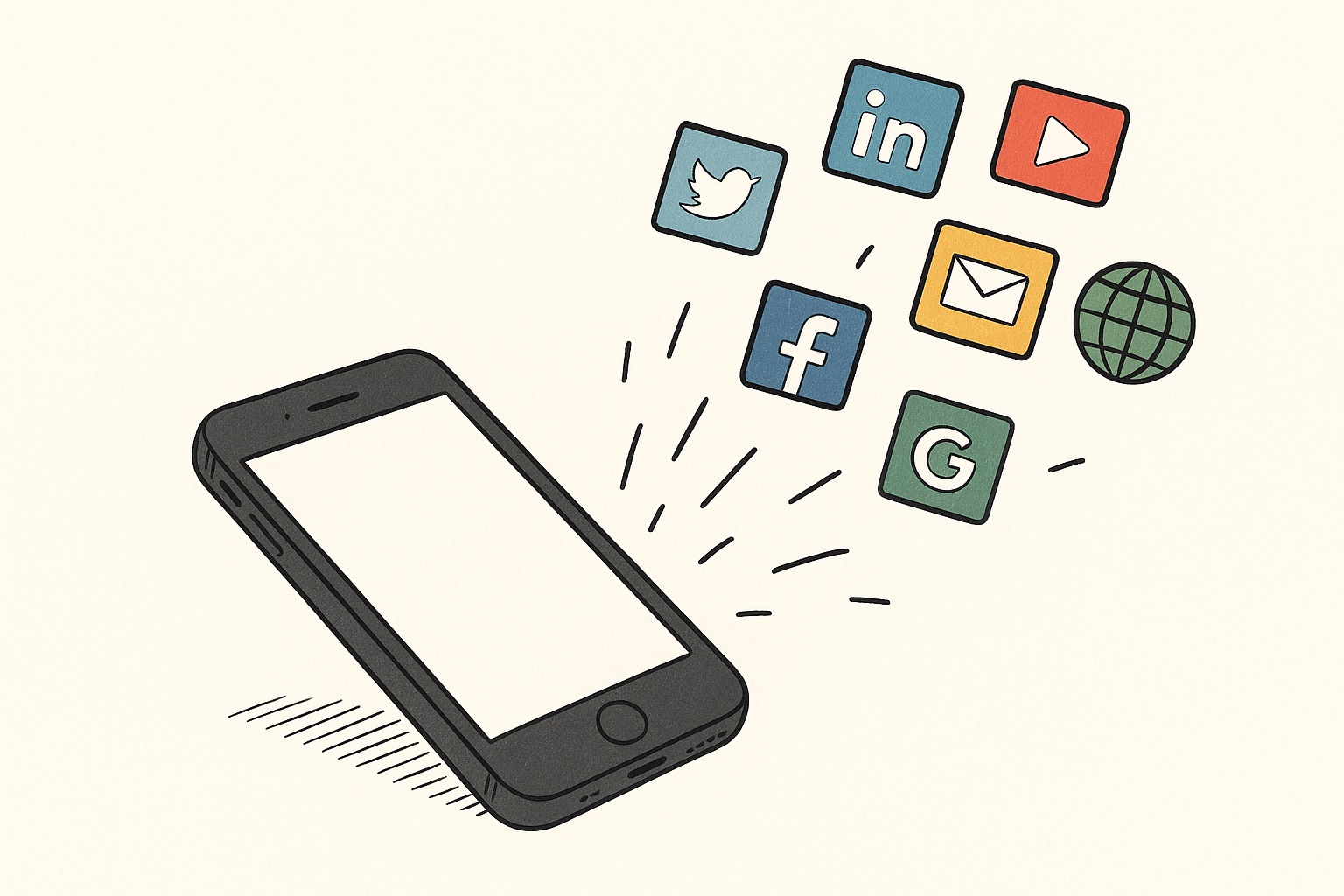
Content is the heart of your event, but its real power extends beyond the presentations on the main stage. To boost attendance, you need to architect an experience that people are eager to share. The goal is to turn your attendees into your most authentic and effective promoters.
This all starts with your agenda. It is not enough to cover broad topics. You have to drill down into the specific, nagging challenges your audience is dealing with right now. What is keeping them up at night? What new skill will help them snag that next promotion? When your session topics and speakers make attendance feel essential, you have already won half the battle.
Engineer "Instagrammable" Moments
While educational content gets people in the door, it is the experiential elements that create buzz. These are the "Instagrammable moments" that attendees are genuinely excited to capture and post.
Think bigger than a simple logo backdrop. We are talking about interactive installations, one-of-a-kind photo ops, or even gamified sessions that beg to be shared online. The idea is to create experiences that are visual, engaging, and fun, which naturally leads to a flood of user-generated content (UGC).
Great event content does more than just inform; it inspires people to act. When an attendee posts a photo or video from your event, they are giving a personal, public thumbs-up. That kind of social proof is infinitely more powerful than any ad you could buy. This organic promotion builds a compelling story around your event in real-time, showing potential attendees exactly what they are missing and creating a powerful sense of FOMO that can drive last-minute registrations.
Turn Fleeting Experiences Into Lasting Stories
All the amazing content generated at your event needs a home and a clear purpose. If you plan how you will capture and reuse these moments, you can extend the life of your event and build a treasure trove of assets for future marketing.
A video testimonial booth or a virtual event microsite are great ways to collect these digital stories. They make it easy to gather authentic reactions and feedback from attendees right when their excitement is at its peak.
- Video Testimonials: Prompt attendees with simple questions like, "What was your biggest takeaway today?" or "What was your favorite moment?" The short, genuine video clips you get are pure marketing gold for your next event's promo campaign.
- AI Photo Booths: An AI photo booth can produce stunning, unique images that attendees will be scrambling to share. When you brand this content, every social media post becomes a micro-advertisement for your event.
- Virtual Microsites: A dedicated site can pull together all the content from an event, from official photos to attendee posts, creating a living gallery that captures the energy and value of the experience.
These strategies do more than just capture memories; they generate a library of authentic marketing assets. The visuals and testimonials become the foundation of your post-event recap and the engine for your promotional campaign next year. Our guide on how to use event photography in your marketing strategy is packed with more ideas.
By designing every element of your event with shareability in mind, you create a powerful, self-sustaining promotional cycle that will help increase event attendance, year after year.
Expanding Your Reach With Hybrid and Virtual Options
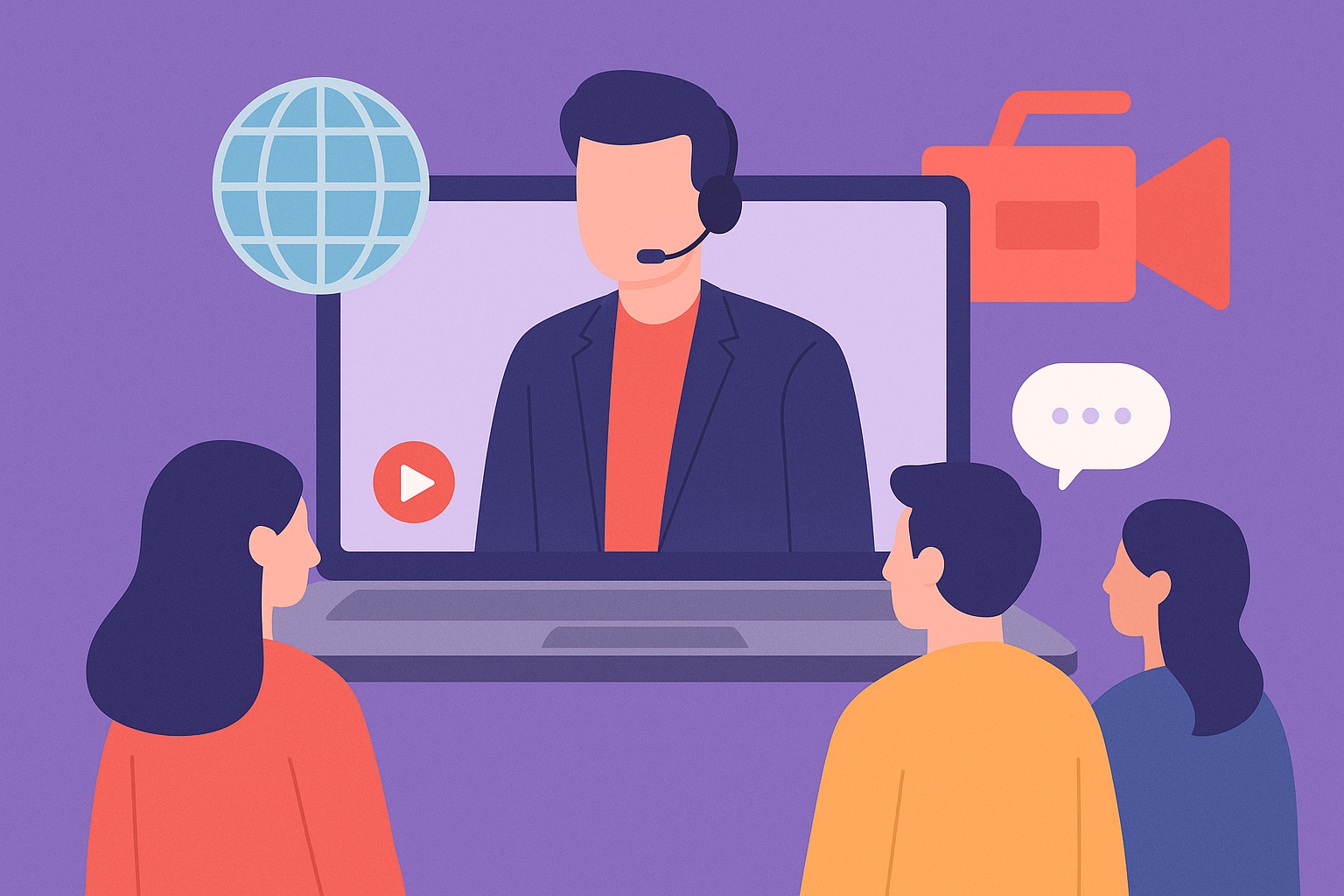
One of the easiest ways to get more people to your event is to remove the obstacles keeping them away. Not everyone has the time or budget for travel and hotels, but that does not mean they are not interested in what your speakers have to say.
By adding a hybrid or fully virtual option, you are not just opening a door; you are tearing down geographical walls. This instantly transforms a logistical headache for many into a massive opportunity for you to grow your audience. A virtual ticket makes your event more accessible and can even act as a "try before you buy" for those who might commit to an in-person ticket next year.
Designing a Compelling Virtual Experience
A successful hybrid event is about more than just pointing a camera at the stage. If your remote attendees feel like they are just watching a low-budget livestream, they will tune out. The goal is to make them feel just as included and engaged as the people in the room.
To achieve this, you need to architect a digital experience that is interactive and genuinely valuable. Think beyond a simple feed.
- Dedicated Digital Host: Assign someone to be the "emcee" for your virtual crowd. They can guide the audience, field questions, and maintain energy.
- Interactive Sessions: Use tools like live polls, Q&A sessions, and digital breakout rooms to get people involved. Do not let them be passive viewers.
- Exclusive Virtual Content: Give your remote attendees something extra, like a behind-the-scenes tour or a special Q&A with a keynote speaker after their talk.
The numbers back this up. The virtual event market is set to grow from $236.69 billion in 2025 to $537.18 billion by 2029. Virtual formats can cost 75% less than in-person events while boosting lead capture by up to 30%. With 80% of virtual attendees joining for educational content, they are a motivated and valuable audience.
Comparing Hybrid vs In-Person Events
Deciding between a purely physical event and a hybrid model involves weighing several factors. This table breaks down the key considerations to help you choose the format that best aligns with your attendance goals and resources.
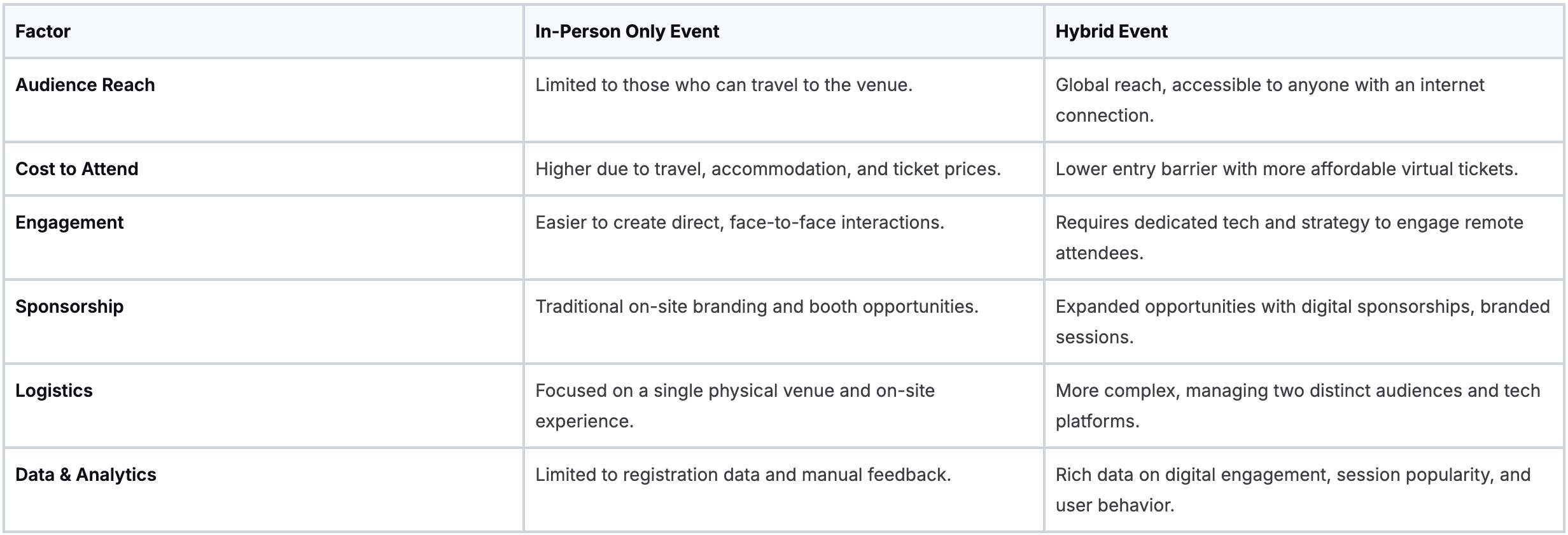
The right choice depends on your specific goals. If maximizing reach and accessibility is your top priority, a hybrid event is hard to beat. If you are focused on a high-touch, exclusive experience, in-person might be the way to go.
Bridging the Gap Between Physical and Digital
To create a truly unified event, you need technology that connects your two audiences. The aim is to build shared experiences that make everyone feel like they are part of the same community, whether they are in the conference hall or on their couch.
A successful hybrid strategy makes location irrelevant. It fosters a single, unified community where every attendee, whether in the room or on a screen, feels like a first-class participant.
Interactive tools are your best friend here. For example, an online photo booth can be used by both in-person and virtual attendees. Everyone uses their own device to snap branded photos or GIFs, which can then feed into a live digital mosaic displayed on screens at the venue and on the virtual platform. Suddenly, you have a powerful, shared experience generating content that reflects your entire audience. You can dive deeper into these strategies in our guide on how to use an online photo booth for event engagement.
By offering a robust virtual option, you are doing more than just selling extra tickets. You are building a more resilient, inclusive event that signals a commitment to accessibility and innovation, making your event a can't-miss experience for a much wider audience.
Keeping the Momentum Going Post-Event
The work does not stop when the last attendee leaves. In fact, that is exactly when the groundwork for next year’s event begins. Your mission is to capture all that energy and keep the conversation going, transforming this year's attendees into next year's biggest fans.
An effective post-event strategy is your secret weapon. It reminds people of the value they received and, just as crucially, creates serious FOMO for everyone who missed out. This is how you turn first-timers into loyal advocates who not only come back but also bring their colleagues along.
Capitalize on Post-Event Momentum
Right after your event, your attendees are buzzing. This is your golden window to lock in that positive feeling and make it last. Do not let the excitement fizzle out.
Move quickly by sharing high-quality highlight reels, professional photo galleries, and recordings of the best sessions. This content serves a dual purpose. For those who were there, it is a great way to relive their favorite moments or catch a talk they missed. For everyone else, it is a tangible, powerful glimpse into what they missed, making a strong case for why they must be there next time.
The best post-event marketing does not feel like marketing at all. It feels like a celebration of a shared experience, inviting everyone to relive the highlights and see what made the event so special.
Photo galleries, especially from something like an AI photo booth, are incredibly powerful. The unique, super-shareable images that attendees create themselves become an authentic showcase of your event's vibe. When people see their friends and peers in creative, branded photos, it builds an instant personal connection and a real desire to be part of the action.
Use Feedback to Fuel Future Growth
While sharing highlights keeps the energy up, gathering feedback fuels your long-term success. A post-event survey is your direct line to understanding what really landed with your audience and where you can improve. Just remember to keep the survey short, to the point, and easy to fill out.
Ask specific questions to get insights you can actually use:
- Which session was most valuable to you and why?
- What was your favorite networking or interactive experience?
- What topics would you love to see covered next time?
This feedback is pure marketing gold. It helps you tailor future content, pick speakers who resonate, and design experiences you know your audience is hungry for. This simple feedback loop shows you value your community's opinion, which goes a long way in building loyalty. For non-profits, this kind of engagement is vital; you can find more tips in our guide on virtual photo booths for fundraising and community building.
Nurturing a Year-Round Community
The good news is that the industry is feeling optimistic, too. A 2025 forecast from American Express Global Business Travel found that 74% of top meeting professionals are bullish on the industry's future, with 66% expecting to increase their event budgets. That increased funding means organizers can invest more in the exact kinds of tech and experiences that boost engagement and keep people coming back.
Technology, especially AI and data analytics, is changing how we deliver content and track what attendees truly value. You can dive deeper into how tech investments are boosting attendance in the latest event industry trends.
By riding this wave of post-event momentum, you are not just wrapping up one event; you are kicking off the pre-promotional campaign for your next one. This sets a solid foundation for growth and ensures you will have a packed house year after year.
Frequently Asked Questions
When you're trying to pack a room, a multi-channel strategy almost always comes out on top. It is not about being everywhere, but being everywhere that matters for your audience. Email marketing, for instance, is still a powerhouse for converting people who are already interested, especially when you segment your lists for more personal, relevant messages.
For B2B events, you cannot beat LinkedIn. It is the perfect playground for targeted outreach and sharing content that screams industry value. But if you are running a B2C event or something more experiential, platforms like Instagram and TikTok are your best friends. They are built to show off the energy and visual appeal of your event through a mix of organic posts, paid ads, and influencer collaborations. Never forget about strategic partnerships. Teaming up with industry associations or complementary brands is a fantastic way to tap into their ready-made, qualified audiences.
How Far in Advance Should We Market an Event?
The honest answer is that it depends on the scale of your event. If you are planning a massive conference, you need to start making noise 6 to 9 months out. That gives you enough runway to build a solid promotional engine, lock in A-list speakers, and effectively use early-bird pricing.
For smaller-scale workshops or local meetups, a 2 to 4-month lead time is usually sufficient. The key is to map out a timeline with clear phases: an initial "save the date" blast, the big agenda reveal, ongoing speaker spotlights to build hype, and then a final, high-urgency push to snag last-minute sign-ups.
What Are Some Budget-Friendly Ways to Boost Attendance?
You do not always need a monster budget to fill seats. In fact, some of the most effective tactics are organic and focus on high impact without the high cost.
Here is where we would put our money:
- Create Content People Want to Share: This is huge. Develop content that your attendees and partners are genuinely excited to share with their networks. Think insightful blog posts, eye-catching infographics, or short, punchy video clips from your speakers.
- Lean into UGC: Get your attendees to do the marketing for you. Create a unique event hashtag and make a big deal out of featuring their posts. People love the recognition, and it is authentic social proof.
- Activate Your Network: Your speakers and sponsors are your secret weapon. Partner with people who are willing to promote the event to their own followers. It is free, it is authentic, and it hits a perfectly qualified audience.
- Offer Virtual Access: Adding a virtual component is a smart, cost-effective way to expand your potential audience size. You can reach a global audience without the overhead of a bigger venue.
How Can Tech Like an AI Photo Booth Drive Registrations?
This is one of our favorite strategies. You can use unique tech experiences as a major selling point to get people to click "register." In your marketing, do not just talk about the sessions and speakers. Make a point to highlight that attendees can get professional, AI-enhanced headshots or create fun, branded GIFs at an AI photo booth.
This simple move transforms a fun feature into a tangible, valuable incentive. It sends a clear signal: this event is modern, innovative, and all about delivering a premium, memorable experience for everyone who walks through the door.
When you promote these kinds of shareable moments, you create powerful FOMO (fear of missing out). It positions your event as a can't-miss opportunity for both learning and creating cool, valuable content for their own personal brand. That little value-add, beyond the main agenda, can be the final nudge someone needs to commit.

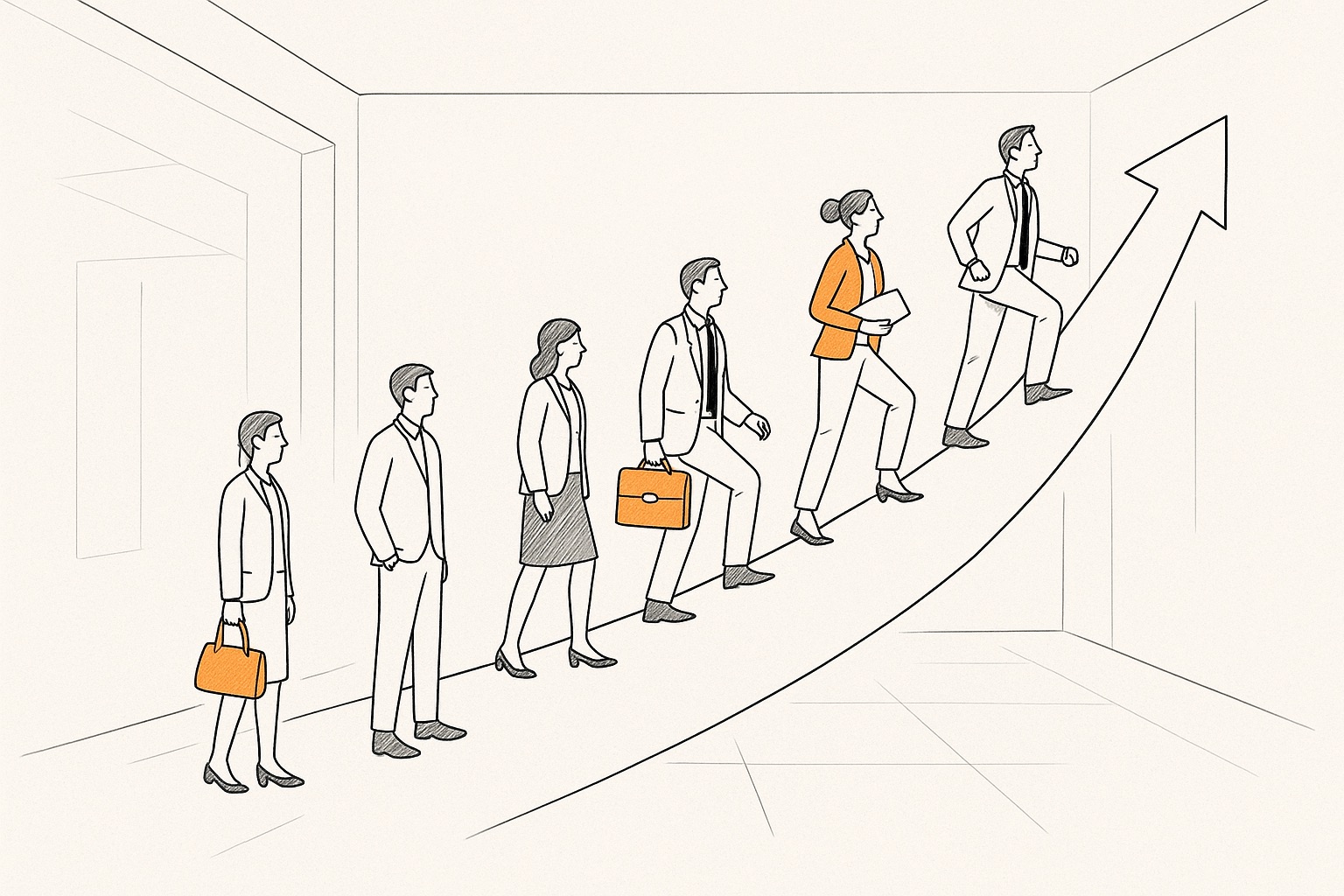








-p-500.webp)



.jpeg)















